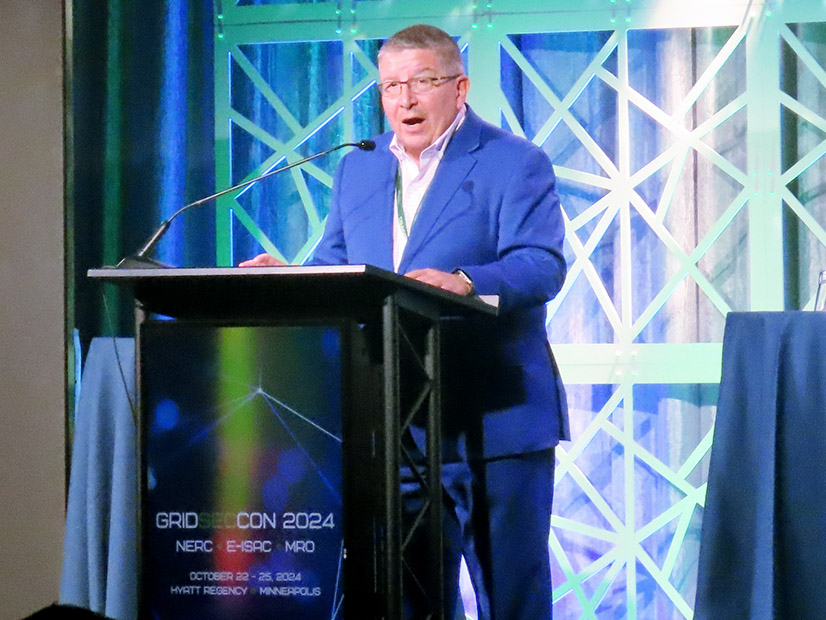NESCOE Seeks Feedback on LTTP Solicitation Structure
The New England States Committee on Electricity (NESCOE) remains “open to various ways to structure the scope” of the first transmission solicitation of the new longer-term transmission planning (LTTP) process, NESCOE’s Sheila Keane said Oct. 23.
NESCOE recently announced the states’ intention to focus the first LTTP solicitation on increasing the region’s north-south transmission capacity, with a particular focus on unlocking renewables in northern Maine. (See New England States Seeking Increase of North-South Tx Capacity.)
Keane asked for stakeholder feedback on how to structure the solicitation, adding that the states are trying to balance the need for strong minimum requirements for proposals while also leaving enough room for a wide range of potential solutions.
Northern Maine is not currently connected to the ISO-NE grid, but Maine is planning solicitations for renewable generation and associated transmission in this part of the state. (See Long Road Still Ahead for Aroostook Transmission Project.)
Phil Bartlett, chairman of the Maine Public Utilities Commission, said the state’s request for proposals (RFP) will be “at least somewhat dependent” on the LTTP solicitation.
“As we’re thinking about our northern Maine procurement, we are watching this very closely,” Bartlett said, adding that he is “hopeful that this process will provide some of those downstream upgrades that increase the likelihood of [a state-selected] project.”
However, there remains a long road ahead before any project is selected through the LTTP process. ISO-NE indicated that it expects to issue an RFP around March, followed by an approximately six-month application window and up to a year for ISO-NE to evaluate and develop a cost-benefit analysis for all the proposals.
Keane stressed that there is a lot of work to be done before ISO-NE can issue an RFP and said NESCOE is planning to continue discussions about the RFP with stakeholders at the PAC in the coming months.
Asset Condition Projects and Updates
Dave Burnham of Eversource Energy, representing the six major New England transmission owners (NETOs), provided an update on the asset condition project process guide, which the NETOs are developing in response to concerns from the states about a lack of oversight and transparency in the development and selection of projects.
He said the NETOs now require transmission owners to consider a “base alternative” representing the “minimum solution which addresses the identified asset condition problem.”
Additional changes to the process guide include standardized grading categories for asset condition evaluations and more transparency into how the decisions are made, Burnham said.
Eversource also provided an update on its proposal to rebuild the X-178 transmission line in New Hampshire, which cuts through the White Mountain National Forest. The project has proven to be particularly controversial, receiving pushback from NESCOE and the New Hampshire Office of the Consumer Advocate, and is the subject of a lawsuit from two local property owners.
The company previously told the PAC a full rebuild of the line would be the most cost effective way to address degradation on its wood poles, while NESCOE has expressed concern that the company has not adequately justified the project, threatening action with FERC. (See New England States Raise Alarm on Eversource Asset Condition Project.)
The states ultimately have little oversight over asset condition projects – the transmission owners are responsible for assessing the condition of their lines, determining whether upgrades are needed and selecting the most cost-effective solution. The transmission owners’ spending on the lines is FERC jurisdictional under the cost-of-service model.
As the costs associated with maintaining the region’s aging grid have accelerated in recent years, this process has drawn increased scrutiny into whether the transmission owners are doing enough to minimize the price of these upgrades.
Chris Soderman of Eversource said the cost projection of the full X-178 rebuild has decreased from $384.6 million to $360.6 million since the company presented the project in June “based on bids received.”
Soderman stressed that upgrading the line in a more piecemeal fashion would ultimately increase costs for ratepayers, with the estimated price tag ranging from $467 million to $614.1 million.
Kris Pastoriza, a property owner who has sued to stop the project, said Eversource’s proposed construction methods and overly impactful and “unethical.” Pastoriza argued the photo evidence of the pole degradation provided by the company is unconvincing and called on the company to release its pole inspection reports.
Meanwhile, some stakeholders, including a representative of Wagner Forest Management and Abigail Krich of Boreas Renewables, expressed support for Eversource’s proposal to address all the asset condition needs at one time, instead of addressing the needs through multiple project phases that could cause repeated disturbances.
Representatives of the Vermont Electric Power Company (VELCO) and National Grid also presented asset condition projects to the PAC:
-
- National Grid is proposing to replace all structures, reconductors and install optical ground wire (OPGW) on a line in eastern Massachusetts, with a projected cost of about $74 million.
- The company is also proposing to spend about $9 million to refurbish a substation in Worcester, Mass.
-
VELCO outlined a project to replace 41 structures on a line in northern Vermont, with a total estimated cost of about $6 million.
Boston 2033 Solutions Study
Andrew Kniska updated the PAC on the status of the Boston 2033 Solutions Study, which aims to address issues identified in the Boston 2033 Needs Assessment, published earlier in 2024.
While the needs assessment initially found several time-sensitive overload issues, a combination of modeling error corrections and new asset condition projects have eliminated all peak load time-sensitive needs, Kniska said.


